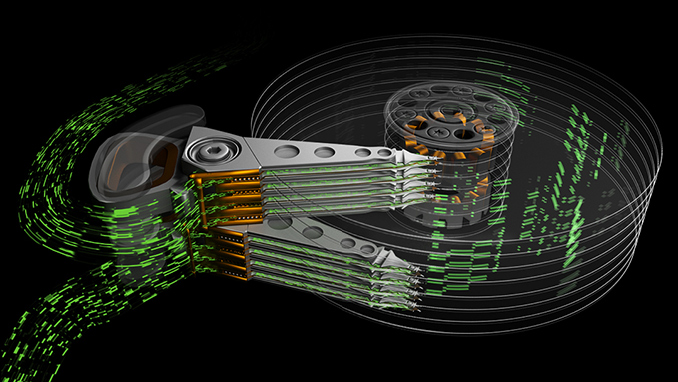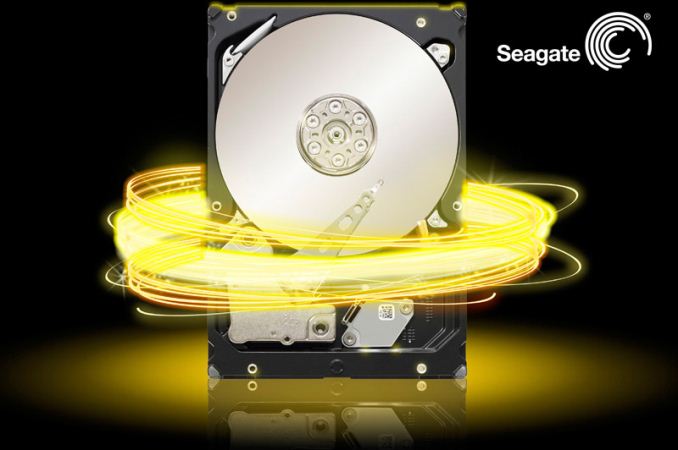Seagate’s Multi Actuator Technology to Address HDD IOPS Woes
by Anton Shilov on December 29, 2017 12:01 PM EST
Seagate introduced its new Multi-Actuator Technology (MAT) for hard drives earlier this month. It promises to increase hard drive performance by using two or more sets of actuator arms that operate independently from a single pivot point. Seagate claims that next-gen HDDs will require higher performance to effectively take advantage of their increased capacities. It plans to use MAT in their datacenter hard drives going into pilot production in 2018.
To improve the performance of next-generation hard drives, Seagate proposes to install not one, but two (or more) sets of actuators into a single HDD. The actuators are to be equipped with their own arms/heads as well as magnets to position them, but will use one pivot. As a result, the actuators will be able to act completely independently, essentially creating parallelism within a single hard drive. With an architecture like this, IOPS performance will scale with the number of actuators. Aggregate read/write performance of hard drives will also increase, but since it will depend on many factors, it is too early to make predictions regarding throughput of next-gen HDDs. The additional components required for two independent actuator assemblies (and a considerably more sophisticated HDD controller) will make such hard drives more expensive to build when compared to today’s models. This could be one of the reasons why Seagate plans to use its Multi-Actuator Technology only for hard drives designed for datacentres, where hardware costs are not as crucial as performance and features.
The first-generation MAT-enabled HDDs are to use two actuators operating on a single pivot point (along with 8 platters and 16 heads), but going forward the number of actuators may grow. Seagate says that the host computer can “treat a single Dual Actuator drive as if it were two separate drives”, but stresses that logically the HDD will remain a single device with two access streams for communication, just like dual-port SAS drives do. Meanwhile, Dual Actuator HDDs will be able to use not only SAS, but also NVMe and SATA interfaces. In the best-case scenario, a hard drive with two actuators can double the random read/write performance and almost double the sequential read/write performance compared to today's hard drives. The sequential access case is a bit tricky, since the cylinder height gets halved with two actuators, and a lot depends on how the addresses are translated to the actual physical sectors.
The arrival of new magnetic recording technologies in the coming years will significantly increase capacities of hard drives for cloud/exascale datacenters to over 20 TB by 2020 and to 40 TB within the next five or seven years. The upcoming HDDs will increase their sequential read/write performance along with the increase of their areal densities, but when it comes to latencies and random read and write operations, things get more complicated. The current HDD architecture uses a single actuator that synchronously moves all the arms with read-write heads over the media together for reading and writing data. With such an architecture, the platters can only work on one request at a time. Meanwhile, the more data an HDD stores, the more requests it gets and the more time it spends seeking the right track/sector. If/when fulfilling a request takes too long, quality of service (a metric dear to datacenter operators) suffers. Today, the performance bottleneck is solved by using either NAND flash or multiple hard drives in parallel, effectively combining their performance for certain access traces. At some point, this approach may become inefficient due to power/complexity and other factors. Therefore, it is imperative that HDDs get faster in order to cope with tomorrow’s workloads.
Seagate says that the Multi-Actuator Technology is to be deployed on products in the near future, but does not disclose when exactly. As the company’s blog post on the matter mentions both MAT and HAMR, it is highly likely that commercial hard drives featuring HAMR due in late 2019 will also have two actuators on a single pivot. At the same time, it does not mean that the MAT is not going to find itself a place in products using conventional PMR.
Related Reading
- Western Digital Stuns Storage Industry with MAMR Breakthrough for Next-Gen HDDs
- Toshiba Announces 14 TB PMR MG07ACA HDD: 9 Platters, Helium-Filled, 260 MB/s
- Toshiba Commercializes SDK’s 9th Gen PMR, Tech Enables 14 TB PMR HDDs in 2018
- Western Digital Now Shipping 14 TB HDDs: HGST Ultrastar Hs14 with 1000 Gb/in2
- Western Digital Announces Ultrastar He12 12 TB and 14 TB HDDs
- Seagate Announces Enterprise Capacity 12 TB HDD: 2nd-Gen Helium-Filled Hard Drives
Source: Seagate











88 Comments
View All Comments
FunBunny2 - Monday, January 1, 2018 - link
"which does propagate at the speed of light — more or less."not really. very much less
"Answer 3:
Light travels through empty space at 186,000 miles per second. The electricity which flows through the wires in your homes and appliances travels much slower: only about 1/100 th the speed of light. Part of the reason is that light is massless; it has no weight, whereas the electricity flowing in the wires is made up of a stream of electrons, all of which have some small amount of weight. In addition, the electrons flowing through the wires constantly bump into the atoms of the wire, which slows them down considerably. If you were to take the electrons out of the wire and make them flow through space (which is essentially what you do when you make a spark), they can move faster, but no matter what, they cannot move as fast light."
here: http://scienceline.ucsb.edu/getkey.php?key=2910
FunBunny2 - Monday, January 1, 2018 - link
and this overstates somewhat. according to my physics teacher: electricity doesn't propagate as water through a pipe, electrical fields through anything. what happens: an electron enters the wire, which promptly hits an electron of an atom of the wire. the hit electron then heads off and hits an electron of its atom, or another, repeat prodigiously. or, IOW, nearly no electron (or wave or whatnot) travels from one end of the wire to the other. it's massive bumper cars on a quantum playing field.UpSpin - Tuesday, January 2, 2018 - link
"The electricity which flows through the wires in your homes and appliances travels much slower: only about 1/100 th the speed of light."But we don't care about the electron flow, but the energy flow. The electrons are the carriers, the same as the water molecules. But to transmit energy, neither the water molecules, nor the electrons have to reach the end of the water hose, or the end of the wire. The electrical energy, and thus the signals, are transmitted by the electromagnetic wave around the wire. An this wave propagated with 50%-99% of the speed of light, depending on the medium.
https://en.wikipedia.org/wiki/Velocity_factor
letmepicyou - Tuesday, January 2, 2018 - link
I tend to think you could come a lot close to SSD performance if you made each actuator arm move independently rather than grouping them. You're always going to have a seek time, but we've only scratched the surface as far as "normal" hard drive performance. Sure we've added things like NCQ, increased areal density, and slapped on bigger buffers. But there are so many other things you could do...independent actuator arms could theoretically allow you to create a RAID array inside a single drive. I sense a lot of untouched possibilities.mode_13h - Wednesday, January 3, 2018 - link
One benefit of linking the arms would seem to be mechanical rigidity. Making them all independent might also make them too bouncy.Also, consider that moving the arm also jerks the spindle in the opposite direction. So, each actuator might need to compensate for the effects of the others on the spindle's precise location. That could add a lot of computational overhead, as you scale up the number of actuators.
Sivar - Friday, December 29, 2017 - link
This has been done before by Seagate in the 90's.mode_13h - Friday, December 29, 2017 - link
Perhaps, but it gets much harder when your areal density increases enough that you have to compensate for the movement of the spindle caused by other actuators. I won't repeat any more of what I said above, but perhaps that was a factor the technique falling into disuse.Sivar - Friday, December 29, 2017 - link
This was done before by Seagate in the 90's. Seagate sold a drive where each platter had its own actuator. STR was about double that of a standard drive (I don't remember how many platters these had, probably 3), but the product was abandoned due to high costs and greater complexity.That's still the case. You can get better performance by adding more drives, especially when not using performance-killing RAID5 or RAID6 configurations. For high IOPS loads, we now have SSDs and Intel's Optane.
mode_13h - Friday, December 29, 2017 - link
RAID is only a real performance problem when a significant number of your writes are updates to records smaller than your stripe size. If you're reading & writing mostly whole stripes, then it's all good.Sivar - Saturday, December 30, 2017 - link
A true statement, though the article's title suggests that IOPS is the goal, which usually implies the need for small, random IOs.